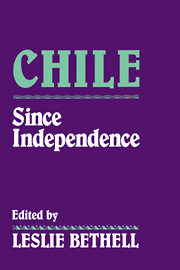1 - From independence to the War of the Pacific
Published online by Cambridge University Press: 05 June 2012
Summary
At a banquet in Valparaíso in 1852 the Argentine publicist Juan Bautista Alberdi proposed a toast to ‘the honourable exception in South America’. In one very important respect, the story of nineteenth century Chile was, it is true, a striking exception to the normal Spanish American pattern. Within fifteen years of independence Chilean politicians were constructing a system of constitutional government which was to prove remarkable (by European as well as Latin American standards) for its durability and adaptability. This successful consolidation of an effective national state excited the envious admiration of less fortunate Spanish American republics, torn and plagued as so many of them were by recurrent strife and caudillo rule. A good part of the explanation of Chile's unusual record undoubtedly lies in what can best be called the ‘manageability’ of the country at the time of independence, not least in terms of the basic factors of territory and population. The effective national territory of Chile in the 1820s was much smaller than it is today. Its distinctive slenderness of width – ‘a sword hanging from the west side of America’ – was for obvious orographical reasons no different; but lengthways no more than 700 miles or so separated the mining districts in the desert around Copiapó, at the northern limit of settlement (27°S), from the green and fertile lands along the Bío-Bío river in the south (37°S) – the area traditionally referred to as the Frontier, beyond which the Araucanian Indians stubbornly preserved their independent way of life.
- Type
- Chapter
- Information
- Chile since Independence , pp. 1 - 32Publisher: Cambridge University PressPrint publication year: 1993
- 3
- Cited by



